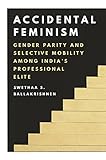Accidental feminism : gender parity and selective mobility among India's professional elite / Swethaa S. Ballakrishnen.
Publisher: Princeton, New Jersey : Princeton University Press, 2021Copyright date: ©2021Description: xviii, 266 pages : illustrations ; 24 cmContent type:- text
- 9780691213606
- 0691213607
- 9780691182537
- 340.082054
- KNS53.35.W6 B35 2021
| Item type | Current library | Shelving location | Call number | Materials specified | Status | Notes | Barcode | |
|---|---|---|---|---|---|---|---|---|
 BOOKs
BOOKs
|
National Law School | General Stacks | 340.082054 BAL (Browse shelf(Opens below)) | PB | Available | Recommended by Dr. Atreyee Majumder | 39808 |
Includes bibliographical references (pages 225-252) and index.
The accidental emergence of India's elite women lawyers -- Foci: Market liberalization and the changing nature of professional work -- Frames: Women can't match up : the sticky assumptions of gender and work -- Firms: Just like an international firm : the advantage of not being -- Facings: My cclients prefer a woman lawyer : new returns to essentialism -- Families: It is (not always) difficult once you have a family : work, life, and balance -- Futures: Now what? : what do we do with the accidental?
Exploring the unintentional production of seemingly feminist outcomes In India, elite law firms offer a surprising oasis for women within a hostile, predominantly male industry. Less than 10 percent of the country’s lawyers are female, but women in the most prestigious firms are significantly represented both at entry and partnership. Elite workspaces are notorious for being unfriendly to new actors, so what allows for aberration in certain workspaces?Drawing from observations and interviews with more than 130 elite professionals, Accidental Feminism examines how a range of underlying mechanisms—gendered socialization and essentialism, family structures and dynamics, and firm and regulatory histories—afford certain professionals egalitarian outcomes that are not available to their local and global peers. Juxtaposing findings on the legal profession with those on elite consulting firms, Swethaa Ballakrishnen reveals that parity arises not from a commitment to create feminist organizations, but from structural factors that incidentally come together to do gender differently. Simultaneously, their research offers notes of caution: while conditional convergence may create equality in ways that more targeted endeavors fail to achieve, “accidental” developments are hard to replicate, and are, in this case, buttressed by embedded inequalities. Ballakrishnen examines whether gender parity produced without institutional sanction should still be considered feminist.In offering new ways to think about equality movements and outcomes, Accidental Feminism forces readers to critically consider the work of intention in progress narratives.
There are no comments on this title.
